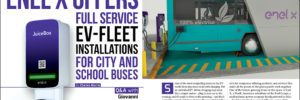
Q&A with Giovanni Bertolino, Head of E-Mobility at Enel X
Some of the most compelling stories in the EV world these days have to do with charging. For an individual EV driver, charging may seem like a simple matter—plug in your car in the evening, and it’s ready to drive in the morning—and that’s part of the appeal of driving electric. However, behind the plug, there’s a complex ecosystem that’s still taking shape, and it’s full of challenges and opportunities for automakers, infrastructure providers and electric utilities.
Fleet operators are learning that they need help to manage charging in order to maximize the benefits from going electric, and utilities are discovering that EVs present a valuable new resource to make grids run more smoothly and to ease the integration of renewable energy. The opportunities are especially rich for companies offering products and services that make all the pieces of the green puzzle work together. One of the fastest-growing firms in this space is Enel X, a North American subsidiary of the Enel Group, a multinational power company headquartered in Italy.
Enel X is involved in several different sectors of the clean energy ecosystem, and it offers a broad range of solutions to help both individuals and commercial customers electrify their transport operations and optimize their energy usage. Enel acquired the innovative EV charger manufacturer eMotorWerks in 2017, and folded it into the Enel X brand in 2019. eMotorWerks was a pioneer in smart charging, distributed energy storage and vehicle-to-grid services, and now Enel X is taking these concepts to the next level.
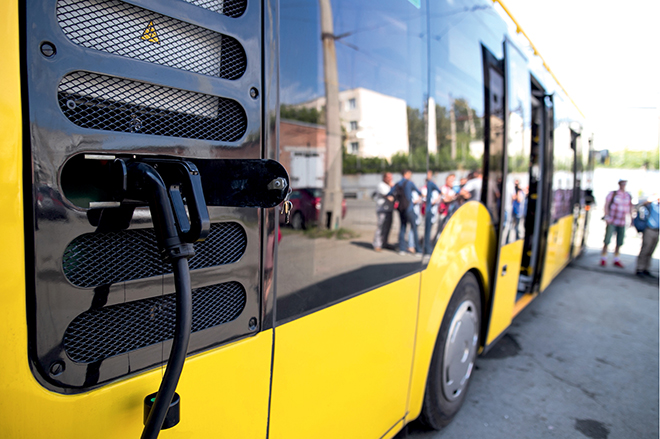
Charged recently spoke with Giovanni Bertolino, Head of E-Mobility at Enel X, and here’s what he had to say.
Charged: You provided over 200 electric buses, along with charging infrastructure, to Santiago, Chile in 2019. Tell us about that.
Giovanni Bertolino: Our ideal is to provide a full turnkey solution to our customers, the city of Santiago and the other cities we’ve been working with. We provide bus route analysis to understand which routes are best suited for electric buses. We then select the buses with the right characteristics to optimally convert those routes. We buy the buses, and we provide the charging infrastructure and set up the depots for the buses to be charged at night or during the day, whenever they are idle. Then we deploy the software to optimize the fleet management, the routes, and the charging of those buses. We also size the charging infrastructure for those depots. Everything is bundled into a turnkey service for cities.
We procure the buses, and in the case of Santiago, we deployed several hundred BYD electric buses and charging infrastructure.
When possible, we can also provide energy services, which means leveraging the bus batteries and Enel X smart chargers to provide flexibility to the grid in the form of demand response or, in the more advanced cases, we can also provide full V2G integration, where you can use the batteries to give back energy to the grid. We have a number of pilots already implementing V2G, and that’s definitely a part of our solution. There are still very few instances where that is becoming a reality, but we are ready to offer that as well.
Charged: Is this kind of turnkey service something that transit agencies are using in the US, or are they typically trying to find the electrification solutions themselves?
Giovanni Bertolino: In the United States there are at least two, or maybe more, relevant markets when we talk about public transportation. There are transit buses and there are school buses. Transit buses are usually managed by transit authorities. School buses are sometimes operated by private companies, but in many cases, cities and school districts own the buses.
There are about 100,000 transit buses across North America, and there are more than 480,000 school buses. Those buses are well suited to be substituted with electric buses. When it comes to transit buses, the penetration is already quite significant globally, because it makes economic sense today.
We believe that our solution might accelerate the transition to e-buses, providing an easier or less capital-intensive up-front solution for transit authorities, especially in this period of budget cuts and reductions due to COVID. We believe that, rather than them putting the money up front, or entering a financial lease, a solution of a fleet-as-a-service might be appealing. We have recently started bringing this solution to the United States.
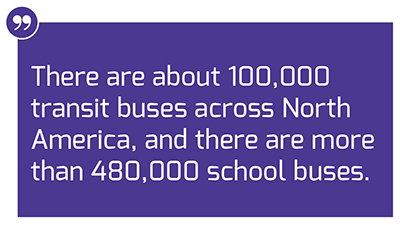
When it comes to school buses, the economics are more challenging. The cost difference between a conventional diesel bus and an electric bus is significantly higher. It’s expensive, regardless of how it is powered, so there is a missing finance issue, which is being solved through grants.
Some school districts and municipalities are willing to push for electrification of their school bus fleets because they are aware of the environmental benefits that they bring, but that investment can be more challenging, getting that funding. With our solution, we can provide easier access to electric buses, because we can package a turnkey solution and the benefits of participating in energy markets. In North America, there are several markets where packaging the solutions can also include the value of energy services that we are able to monetize, and that can make for a better deal for the customer. For electric school buses, this is especially relevant, because they spend much of the day idle, so they can be connected to provide grid services.
Charged: Why is the economic case so much different for school buses than it is for transit buses?
Giovanni Bertolino: Basically, it’s just that the battery pack is expensive. The cost of batteries is going down year after year, but it’s still a very significant cost of acquiring the bus. The fact is that the rest of the bus—the vehicle, the wheels and the rest for the school bus is pretty cheap. When you add the battery pack and the electric transmission, the cost of a school bus goes from a range of $85,000 to $100,000 for a conventional bus to the $350,000 range for an electric school bus, so it’s three times more expensive.
When it comes to transit buses, first of all, they’re much bigger than school buses, they are more sophisticated, and they have better design and features. The hardware of the bus, regardless of the drivetrain, is rather expensive, so when you add the battery pack, the percentage increase from a conventional bus to an electric bus is smaller. And if you couple that with the fact that the transit buses are driving many more miles than school buses, and driving electric saves money for every mile that you travel, transit buses have a business case advantage.
Charged: Tell us about your charging hardware, particularly your JuiceBox line.
Giovanni Bertolino: What we are providing to our customers is a smart charging solution. It’s a solution because it’s hardware, software and services, depending on the customer. And it is smart because our chargers are connected to WiFi and the electric grid. JuiceNet, our Internet of Things software platform, connects all of our chargers, and enables a number of services. We provide a number of energy services for dozens of utilities, and also independently participate in energy markets.
We have a line of hardware products. The core product is what we call JuiceBox, which is a smart charger for EV drivers. It’s a Level 2 charger, and we have different power levels. Our lineup ranges from 32-amp to 40-amp to 48-amp products. We also have JuicePump, a 50 kW DC fast charger for public and commercial use.
The Level 2 chargers are single-phase, 240-volt smart home appliances that you can install in your garage or in a parking lot, or that can be mounted on our mounting solutions. These boxes can be configured and managed through an app on your phone, and there is also a dashboard available through the web, through which you can access all the connectivity of the box. You can manage your settings and you can monitor your energy consumption, how much you are spending for driving your car, and other things.
The commercial version, our JuiceBox Pro, has an identification mechanism. Our JuiceNet Enterprise dashboard allows commercial customers to manage multiple charging ports and multiple locations, and so forth. The smart features allow the chargers to participate in utility programs that provide active and passive strategies like demand response or time-of-use rates.
In fact, we are partnering with more than 30 utilities in North America. We provide energy services, like enabling time-of-use rates, demand response, collecting behavioral charging data, and so on. We have very good use cases with Seattle City Light, Puget Sound Energy, Sonoma Clean Power, Hawaiian Electric, Platte River Power Authority and many others.
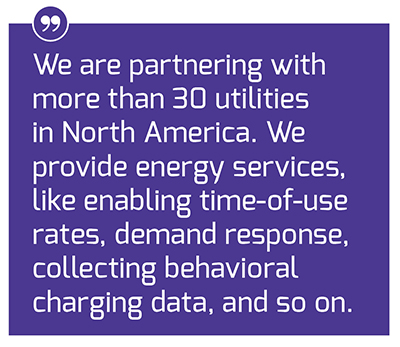
We also provide services directly to grid operators. For instance, in California, we’ve aggregated thousands of our smart chargers, which together make about 68 megawatts of load. And we can manage that load as if it were a virtual battery, by participating in CAISO markets. The value we create by providing the flexibility of those chargers to the grid, we give back to our EV drivers through JuicePoints, a charging rewards program.
This is a rewards program for customers to keep their JuiceBox chargers connected to WiFi, so that they can participate in this program. And it translates into actual money that our customers get back by providing flexibility to the grid. Whenever there is a peak load in California, the CAISO [California Independent System Operator, which manages the grid] can dispatch a signal to reduce consumption to our JuiceBox chargers. So instead of charging the electric cars at full power, we will reduce [power to] all the smart chargers, or some of the chargers, depending on the settings that each customer has set on their phones. We can reduce the load and provide demand response service.
Another smart feature that we provide to our customers is what we call JuiceNet Green. This is a feature that the customer can activate, which keeps track of the generation mix at any moment in time in each grid. We know the carbon intensity of the electrons that are coming into the grid at any given moment, and we can optimize the charging of your car during the time available.
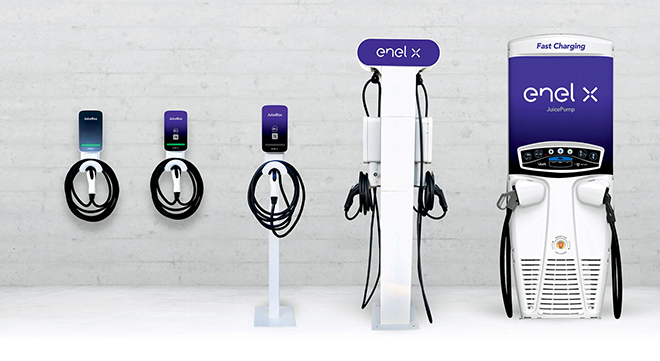
Let’s say you plug in your car when you get home and you set on your phone that you need the car in the morning—that gives us about 11 or 12 hours to charge the car. And we know, given the state of charge, that you will need a smaller number of hours to completely charge your car. We can play with that flexibility, trying to optimize the moment when you charge so that we can minimize the carbon intensity of the electricity that goes into your car. So, you’re driving a bit cleaner than if you were just adding a charger, and that’s something that more environmentally conscious customers really appreciate.
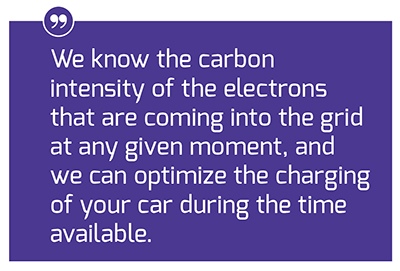
Charged: What are the main customer segments that you’re serving?
Giovanni Bertolino: We’ve historically served the residential market, and we have thousands of smart chargers in homes across North America—many in California, which correlates with EV adoption. This year, we expanded our product line to serve commercial customers, which is an area where we are planning to grow significantly.
In North America, 80 percent of charging happens at home, so we will continue to see demand for smart home chargers. However, this market is closely tied to EV sales, and we also expect to see significant acceleration in the amount of commercial EV infrastructure that will be installed at the workplace, in commercial spaces and with fleets. The more connected electric vehicles there are, the more value we can extract for all stakeholders to save money, through grid services.
This article appeared in Charged Issue 50 – July/August 2020 – Subscribe now.
source https://chargedevs.com/features/turnkey-transit-bus-electrification-enel-x-offers-full-service-ev-fleet-installations-for-city-and-school-buses/
No comments:
Post a Comment